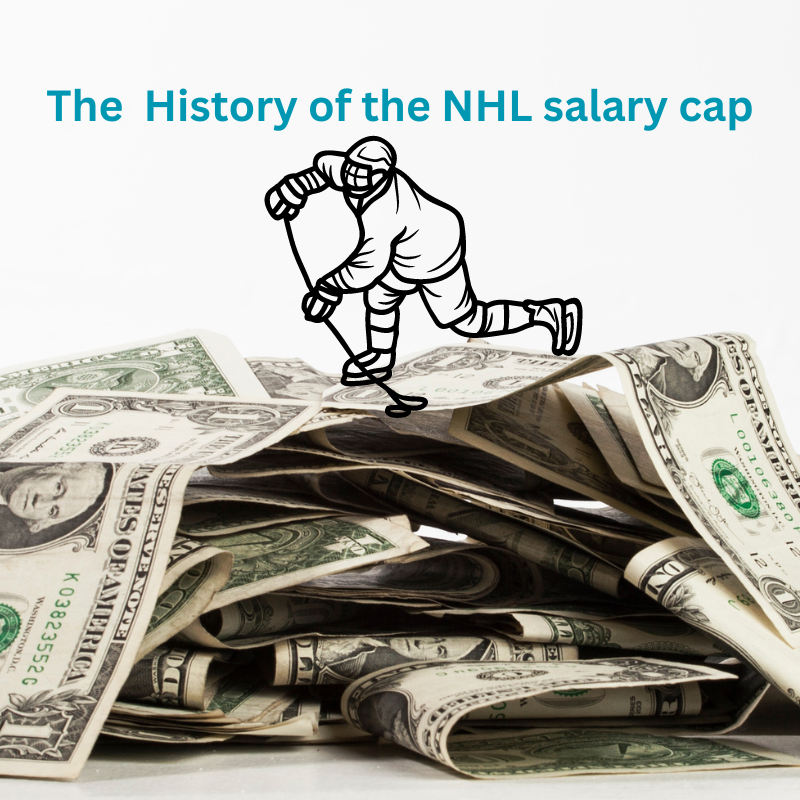The history of the NHL salary cap is an interesting one. Prior to the implementation of a salary cap, the NHL faced significant financial disparities between teams, with wealthier franchises having a significant advantage in terms of player acquisitions and team performance. This led to concerns about competitive balance within the league.

The introduction of a salary cap in the NHL can be traced back to the 1994-1995 season, when a lockout occurred. The lockout was primarily driven by labor disputes between the league and the NHL Players’ Association (NHLPA). As part of the resolution, the NHL and NHLPA agreed to the implementation of a salary cap system.
In 2004, another lockout occurred, lasting the entire 2004-2005 season. The primary objective of this lockout was to address various financial and structural issues within the league. One of the key outcomes of this lockout was the implementation of a salary cap system, known as the “salary cap era,” which has been in place since the 2005-2006 season.
Under the salary cap era, teams in the NHL have been required to adhere to a specific limit on player salaries. This has helped to promote competitive balance within the league by preventing teams with larger financial resources from significantly outspending others.
The initial salary cap for the 2005-2006 season was set at $39 million, and it has increased gradually over the years. For the 2022-2023 season, the salary cap limit was set at $82.5 million. As mentioned earlier, teams are allowed to exceed the cap by utilizing certain exceptions, which provides some flexibility in managing their rosters.
The introduction of the salary cap in the NHL has generally been seen as a positive step in terms of enhancing parity and competitiveness across the league. However, there are ongoing discussions and negotiations between the NHL and NHLPA during collective bargaining agreements to ensure the salary cap system meets the needs of both the league and the players.
The Salary Cap In Other Pro Sports
Salary caps are a mechanism used in professional sports leagues to limit the amount of money teams can spend on player salaries. They are designed to promote competitive balance and prevent wealthy teams from dominating the league solely based on their financial resources. However, the specific details of salary caps vary across different sports. Here’s a comparison of salary caps in hockey, football, basketball, and baseball:
Football (National Football League – NFL): The NFL has a salary cap system that is based on a revenue-sharing model. For the 2021 season, the salary cap was set at $182.5 million per team. The cap can vary from year to year based on the league’s total revenue. NFL teams have the ability to carry over unused salary cap space from one year to the next, allowing for some flexibility in managing their finances.
Basketball (National Basketball Association – NBA): The NBA operates with a “soft” salary cap system. The salary cap for the 2021-2022 season is set at $112.4 million per team. However, the NBA allows teams to exceed the cap to re-sign their own players or sign free agents using various exceptions like the Bird Rights or mid-level exceptions. Teams that exceed the cap are subject to a luxury tax, which is an additional financial penalty.
Baseball (Major League Baseball – MLB): Unlike the other three sports mentioned, Major League Baseball does not have a traditional salary cap. Instead, it has a luxury tax system, often referred to as the “competitive balance tax.” The luxury tax is triggered when a team’s payroll exceeds a certain threshold, which varies from year to year. Teams that exceed the threshold are required to pay a tax based on the amount they are over the limit. The luxury tax acts as a soft deterrent to excessive spending.
Is the concept of the salary cap effective?
The implementation of a salary cap in professional sports, including the NHL, has had a profound impact on the overall landscape of the game. By promoting competitive balance and leveling the playing field, salary caps have helped to create a more exciting and unpredictable sporting environment. These measures have prevented financial powerhouses from dominating solely based on their resources and have given smaller-market teams a fair chance to compete. The salary cap system has not only enhanced the integrity of the sport but has also contributed to the overall popularity and sustainability of professional leagues, ensuring that fans can witness thrilling and closely contested games throughout the season.
Thanks for your time. Please leave comments and suggestions below.




